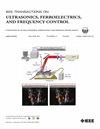Complementary Coded Multiplane Wave Sequences for SNR Increase in Ultrafast Power Doppler Ultrasound Imaging
IF 3.7
2区 工程技术
Q1 ACOUSTICS
IEEE transactions on ultrasonics, ferroelectrics, and frequency control
Pub Date : 2025-06-19
DOI:10.1109/TUFFC.2025.3581350
引用次数: 0
Abstract
Power Doppler imaging is a commonly used technique for visualizing blood flow in ultrasound imaging. This technique measures flow amplitude rather than velocity, and it relies on detecting the power of Doppler signals, making it particularly useful for detecting weak blood flow. The emergence of coherent plane wave (PW) compounding has enabled significant progress in ultrafast power Doppler imaging. However, the lack of transmit focusing leads to a low signal-to-noise ratio (SNR) and contrast, thereby reducing the sensitivity to blood flow, particularly in deep tissue regions. We propose to increase the SNR and contrast of ultrafast power Doppler imaging by leveraging the ideal correlation properties of complete complementary codes (CCC) for multi-PW imaging (MPWI). The MPWI with CCC (MPWI-CCC) method consists of transmitting quasisimultaneously N tilted PWs coded with a binary sequence of length L. Subsequently, the backscattered signals from each PW are individually recovered with high amplitude through decoding. We compared MPWI-CCC and multiplane wave imaging with Hadamard encoding (MPWI-HD) against coherent PW compounding (CPWC) in both simulations and experiments. When transmitting four PWs on a commercial blood flow phantom, MPWI-CCC exhibited the SNR and contrast gains of 13.02 and 10.08 dB, respectively, compared to CPWC. MPWI-HD, on the other hand, achieved gains of only 6.99 and 4.29 dB, respectively.提高超快功率多普勒超声成像信噪比的互补编码多平面波序列。
功率多普勒成像是超声成像中常用的血流显像技术。这项技术测量的是血流幅度而不是流速,它依赖于检测多普勒信号的功率,这使得它对检测微弱的血流特别有用。相干平面波复合技术的出现使超快功率多普勒成像技术取得了重大进展。然而,传输聚焦的缺乏导致低信噪比(SNR)和对比度,从而降低了对血流的敏感性,特别是在深部组织区域。我们提出利用多平面波成像(MPWI)的完全互补码(CCC)的理想相关特性来提高超快功率多普勒成像的信噪比和对比度。MPWI-CCC方法包括准同时发射N个倾斜平面波,以长度为l的二进制序列编码,然后通过解码将每个平面波的后向散射信号分别以高幅度恢复。我们在模拟和实验中比较了MPWI-CCC和Hadamard编码的多平面波成像(MPWI-HD)与相干平面波复合(CPWC)。当MPWI-CCC在商用血流模型上传输4个平面波时,与CPWC相比,其信噪比和对比度分别提高了13.02dB和10.08dB。另一方面,MPWI-HD分别仅获得6.99dB和4.29dB的增益。
本文章由计算机程序翻译,如有差异,请以英文原文为准。
求助全文
约1分钟内获得全文
求助全文
来源期刊
CiteScore
7.70
自引率
16.70%
发文量
583
审稿时长
4.5 months
期刊介绍:
IEEE Transactions on Ultrasonics, Ferroelectrics and Frequency Control includes the theory, technology, materials, and applications relating to: (1) the generation, transmission, and detection of ultrasonic waves and related phenomena; (2) medical ultrasound, including hyperthermia, bioeffects, tissue characterization and imaging; (3) ferroelectric, piezoelectric, and piezomagnetic materials, including crystals, polycrystalline solids, films, polymers, and composites; (4) frequency control, timing and time distribution, including crystal oscillators and other means of classical frequency control, and atomic, molecular and laser frequency control standards. Areas of interest range from fundamental studies to the design and/or applications of devices and systems.

 求助内容:
求助内容: 应助结果提醒方式:
应助结果提醒方式:


